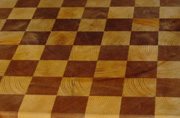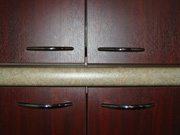Timber and Wood Boards used in Interior Decorating and Design
Find different types of wood boards definitions and their uses in home interior decorating and design.
Plywood
Plywood is stronger and more dimensionally stable than timber of the same thickness. That is because it is constructed by gluing an odd number of sheets of veneer with the grain of adjacent sheets at right angles to each other. This provides stiffness and reduces the amount of moisture movement in the timber. 3 Ply is the most economical and most readily available ply. In the US it was know as “veneered stock”. It comes in many grades, interior, moisture resistant, marine, for use in many varied situations. Timber, metal and plastic decorative veneers are often faced onto plywood.
Blockboard
Blockboard is a sheet product, which is constructed from softwood timber core strips of up to 30mm (1 ¼ in) wide, which are glued between outer veneers whose grain runs in the opposite direction. It is used for shelving, worktops, cupboards and doors. It is less expensive than laminboard.
Laminboard
Laminboard is constructed in a similar fashion as blockboard but the core strips are not more than 7mm wide. It is a finer quality timber board with a better finish than blockboard, with greater stability and the pattern of the timber strips doesn’t show through onto the veneered surface.
Chipboard (Particle Board)
Chipboard is made from chips of timber combined with synthetic resins bonded to form boards (sheets) by applying mechanical pressure and heat. They have a low strength and stiffness, good fire resistance and air tightness. The moisture movement is similar to that of timber. There are two forms of constructing chipboard – they are the extruded method and the platen press method.
The extruded method is the cheapest and weakest of the boards. It is made by extruding or pushing the wood chips and resin through two heated plates, which arranges the particles vertically and they are easily broken off.
The Platen Press method is where the timber chips and resin are pressed between two heated plates which arranges the particles horizontally making the board stronger than the extruded method/ This form of board is available in two forms, single layer (a course surface) or triple layer which has the coarse core with finer chips top and bottom creating a smoother finished board, which is then sanded. The surface can now be painted.
Chipboard sheets are available in three densities, high medium and low. The higher the density, the stronger the board. High Density Board is used for flooring.
MDF Board – Medium Density Fibre Board
This is made by applying high pressure and heat to wood pulp impregnated with resin. It comes in numerous thicknesses ranging from 9mm to 30mm and is used for applying timber, plastic and metallic veneers to. It has revolutionised kitchen design and construction as the carcase and cupboard fronts can all be made from pre finished MDF Board. It is used for all forms of joinery as it is easily cut and has a smooth finish both sides.
Timber Paneling
Traditional paneling has quite a different construction method than today. Originally the paneling consisted of timber framework that was infilled with solid panels of timber. The mouldings were very intricate in profile and made up part of the framework. The panels were solid timber with a profiled exposed face and a rough sawn back face. These were al inset into grooves in the timber framework to allow for expansion and contraction of the timber.
Today timber panelling has been simplified. The framework is simple and the mouldings (if any) are fixed to the face of the framework. The panels are flat and made of timber-veneered board, which generally fits into a rebate in the frame. Modern panels can be of any size and design as the veneered board is very strong and versatile. Often panelling is applied without and visible framework creating a flush surface. Often the edges of the boards are arrised, which means when the two boards are placed together they form a “V”, named “v groove”. The boards (sheets) are fixed invisibly and often glued and screwed.
Laminated Timber
Laminated Timber is made by gluing and mechanically fastening, without cross bands (layers of grain perpendicular to the core grain), layers of veneer or wood. The plies are thicker than those used in plywood. It produces a strong timber product.

Timber Boarding (Match Boarding)
Timber Boarding is where boards are laid side by side with rebates or moldings on each edge so that the straight tongue on one (matches) the groove on the other. This is called tongue and groove. The boards are fixed back to the framing by nailing through the tongue concealing the nail head when the next board is fixed to it. Boards can have v grooved edges, be concave formed and can be fixed vertically, horizontally or diagonally. They can be used as a wall finish, for flooring or as a ceiling finish.
Melamine Prefinished Board
Melamine is a surface composed of a decorative sheet of paper which is covered with a transparent layer of melamine resin. This is a tough surface finish laminated to particle or fibreboard providing a double face prefinished decorative board. It is used for furniture and joinery manufacture. It is not ideal for use in situations of high wear i.e. bench tops, commercial counters or in high humidity areas, shower, sauna. It is borer and fungal resistant. It should not be used close to items of extreme heat – fireplaces or heaters. The edges are covered with either a matching melamine tape or a PVC edge tape. It is available in a range of surface finishes, from high gloss to a woodgrain.

Bench top in plastic laminate, and cupboards in prefinished Melamine board.
Plastic Laminate Prefinished Board
This product is made by bonding together under very high pressure, layers or resin impregnated paper, which has a plastic coated finish onto a hardboard or MDF board backing. It is very hardwearing and durable and can be contoured to prevent sharp edges and untidy joints. It is ideal for kitchen bench tops as a continuous upstand / splashback can be formed and the front edge can be rolled to create a totally impervious surface.
Articles on timber or wood next page is Wood Moldings
